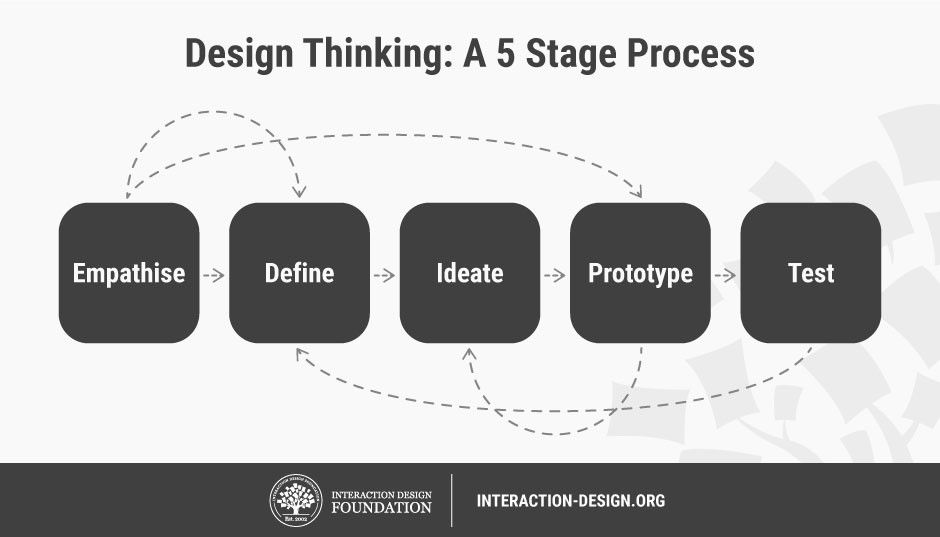短片簡介 (Short Video Introduction)
source: Michelle Humphrey on YouTube
A. 甚麼是設計思維? (What is Design Thinking?)
設計思維是一種解決問題的創意方法,旨在為應用者提供一套思維方法、流程、技術與工具,以應對困難挑戰
Design Thinking (“DT” ) is a creative problem solving methodollgy aimed to provide its practitioner the mindset, process, techniques, and tools to tackle difficult challenges.
這個方法同時是一種創新的過程,幫助人辨識市場的需要,並為滿足此需要而創造一種產品、服務或一套系統。設計思維涉及不斷重複的循環過程,當中包括身同感受 、認清問題、創意發想 、製作原型和實際測試。
It is also an innovation process that will help anyone identify a need in the market and create a product, service, and system to address it. The design thinking process involves an iterative cycle of empathetic observation, problem definition, idea generation, prototyping, and testing.

The Design Thinking Process (Source: Interaction Design Foundation)
身同感受 (Empathize) – 透過觀察和訪問,了解你設計產品的對象。我的用戶是誰?對這些人而言,甚麼是最重要?
Empathize – Learn about the audience for whom you are designing, by observation and interview. Who is my user? What matters to this person?
認清問題 (Define) – 基於用戶的需要,建立一個分析問題的角度。他們的需要是甚麼?
Define – Create a point of view that is based on user needs and insights. What are their needs?
創意發想 (Ideate) – 來個腦力激盪,盡量想出不同的創意方案。意念瘋狂也無妨!
Ideate – Brainstorm and Come up with as many creative solutions as possible. Wild ideas encouraged!
製作原型 (Prototype) – 構思一個或以上的方案,並與其他人分享想法。我可以怎樣展示我的意念?記住:設計原型只是個草稿
Prototype – Build a representation of one or more of your ideas to show to others. How can I show my idea? Remember: A prototype is just a rough draft!
實際測試 (Test) – 將你的意念原型與你原來的用戶分享,讓他們給點意見。哪裡可行?哪裡不可行?
Test – Share your prototyped idea with your original user for feedback. What worked? What didn’t?
B. 設計思維適合哪些人?(Who is Design Thinking for?)
設計思維很適合21世紀的教師和學生,讓他們為持續學習和創造裝備自己。
DT is well suited for 21st century teachers and students to equip themselves for constant learning and creating.
精曉設計思維後,每人也能配備「T型」技能,成為21世紀的原型通才/專才,既擁有縱向的深入專業訓練,同時亦具備解難與跨文化溝通的能力,能在現代網絡與他人合作創新。
By mastering DT, each individual can learn to become a “T-shaped” character, the archtypal generalist/specialist of 21st century talent, who possess in-depth specialized training in verticial disciplines while at the same time possesses the general problem solving and cross-cultural communication capabilities to collaborate with others to innovate across modern networks.
運用設計思維來教授同理心、創意、溝通、合作、批判思考和勇氣這六項21世紀技能是最好不過,因為設計思維強調透過解決現實世界的問題來實踐所學。
Caring (empathy), creativity, communication, collaboration, critical thinking, and courage, the six 21st century skills, are best taught through DT because of its emphasis on learning by doing through solving real-world problem.
在發現問題和想出解決方案的課堂上,同學需要組隊並與擁有不同性格、興趣及長短處的人合作應對挑戰。他們亦需和與問題有關的其他持分者交談,可能包括陌生人。過程要求他們克服害怕被拒絕和失敗的恐懼,堅持完成任務。
In the course of discovering the problem and coming up with a solution, the students have to team up and collaborate with others who have different temperaments, interests, strengths, and weaknesses to address the challenges. They also have to talk to other stakeholders related to the problem who may be strangers to them. This requires them to overcome fear of rejection and failure to complete the tasks with perseverance.
透過學習設計思維,學生不但能獲取這六個21世紀技能,整個過程更增強他們在領導、創新、實驗和承擔風險方面的能力,讓學生在未來變得更自信。
ES learning will benefit tremendously from DT through the acquisition of the 6C skills, which reinforces leadership, innovation, experimentation, and risk taking throughout the entire process. As a result, the students will become more confident in themselves in the future.
C.如何把設計思維融入課程?(How to Integrate Design Thinking into the Curriculum?)
設計思維可用於體驗學習、專題學習和翻轉課室(flipped classroom) 的課程,達致支持教學之用。上課前學生可在網上自習背景資料 (包括參考網站與YouTube影片),亦可作網上討論和品評。
DT can be used in the context of those classes which require experiential learning, project-based learning, and flipped classroom to support the pedagogy. Background materials (including reference websites and YouTube videos) can be posted online for students to study before class and be used for online discussions and comments.
學生可按照所選的題目和興趣分組,從而建立新的友誼,有利組內溝通與合作學習。
The students can be placed into teams resulting from the choice of topics and common interests they share. This enables them to form new peer relationships conducive to communcation and collaboration learning within a group.
獨立專題研究可藉把同理心和製作原型的元素加入課程而變得更豐富,讓學生在情緒方面與持分者建立更緊密的聯繫,驅使他們尋找方法去幫助那些受問題所困擾的人。
Independent Enquiry Study (IES) can be further enriched by incorporating the empathy and prototyping components into the curriculum. This allows the students to form a closer ties with the stakeholders on an emotional level, compeling them to seek for solution to assist those who currently suffer from the consequences caused by the problem.
設計思維又為學生提供機會,探索大家日常關心的獨立專題研究題目,課題會較貼近他們日常生活的經歷。設立原型讓他們學習在個人層面處理有關的議題,甚至可以驅策他們立即行動。課程超越政策研究和建議,補充他們的通識學習。
DT will provide opportunities for students to explore IES topics as everyday concerns, closer to what they experience in their daily life. The development of a prototype will empower them to address the issues related to a topic on a personal level, with possibilities for them to take immediate actions. This will complement their LS learning beyond only policy analysis and recommendations.
再者,設計思維令STEM教育更能針問題,再次聚焦人類的關注點,為學習STEM提供一個目的,以創新解決現實世界的問題,同時亦切合一些教育學家倡議的STEAM (意即增添代表世上最廣義的藝術與人文的字母“A”)理念,為學生提供較STEM 更多整體價值觀的學習。
In addition, DT will make STEM education more problem oriented, putting the human concerns back into the picture. It provides a purpose for learning STEM to solve real- world problems with innovation in mind. This is in tune with the advocacy made by some educators that STEAM (i.e. the addition of letter “A” which represents Arts and Humanities in the broadest sense of the word) will create more holistic values for our students’ learning than STEM alone.
此外,設計思維會令學習經濟課題更富趣味。在經濟學中,學生學習有關分配稀缺資源的三個基本問題:為誰生產、生產甚麼,以及怎樣生產。設計思維會在操作層面處理這三個問題,要求學生將產品或服務的意念轉化為實體原型,以測試其在操作和經濟方面是否可行。
Furthermore, DT will make Economics learning fun. In Economics, students learn about the three fundamental questions related to allocation of scarce resources: For whom to produce; What to produce; How to produce. DT addresses these three questions on an operational level, requiring the students to transform the idea of a product or service into tangible prototype to be tested for its economic feasibility.
總括以上所述,設計思考維的本質為解難和跨學科,適合應用在不同學科上。在21世紀,這正正是我們學生需要的,以追求終生學習,並在改變迅速的世界中,成為適應力更強、創意更佳的人才!
To summarize what has been said, DT due to its problem-solving and interdisciplinary orientation is well suited for application in a variety of subjects. In 21st century, this is exactly what our students need to pursue life-long learning and to become a more adaptive creative talent living in a fast changing world!